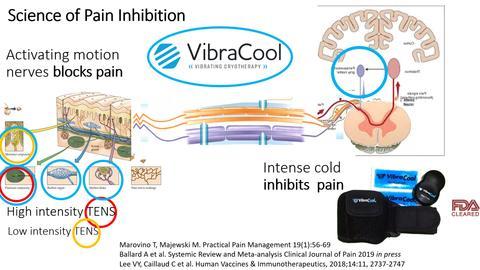Blog
Power Over Pain: Home Care Management

Julius Caesar said “it is easier to find men who will volunteer to die than endure pain with patience.” Dealing with pain takes more than enduring; for chronic pain, it requires strategy and persistence. Pain relief is a marathon, not a sprint, but with an understanding of the nature of pain and new tools home pain management can actually be easier than in a healthcare setting.
Understanding Pain:
The experience of pain is not just nerves firing and signaling the brain. Instead, pain is a complex array of causes and consequences. As an alarm system, pain notifies the brain of danger, just like an alarm system around a vulnerable basement window. With persistent threats, more and more alarms are installed in an attempt to keep the location safe. Once the cause of the danger is gone, alarms may be so sensitive that they still go off. While physical alarms can be uninstalled, dismantling the alarms from chronic pain is less straightforward but just as necessary.
Chronic pain physically changes the brain itself: before knee replacement, the size of the thalamus enlarges from processing pain. Within 6 schrager crunch months after the bad knee (and pain) are gone, it returns to normal size. For pain that doesn’t have a quick fix, part of the treatment has to be retraining the brain to cope with sensations that aren’t actually threats.
Pain scales are great for rating pain in acute or emergency situations where a treatment and change are eminent. Knowing a dose of medicine changes your pain from an 8 to a 3 is useful. At home, however, constantly rating pain draws focus to the pain, increasing the brain’s perception. Just like listening intently to a distant sound makes the sound seem louder, concentrating on pain can make it more. By the same token, pain is reduced when focus is placed on something else. Your elbow may not bother you too much during the tennis game, but when the fun distraction of competition is over, it demands attention!
In order to manage pain at home, it’s also important to understand and make a plan for pain. Pain when you don’t know how to treat it leads to fear and vulnerability. Fear increases the perception of pain, and makes it hard to focus on anything else. Pills can actually increase fear: in order not to build to toxic levels, medicines are timed to peak and then dwindle before you can take more. In the dwindling time before the next medication, the drug level may not be enough to deal with pain. The feeling of “I still hurt – and it’s two hours until the next dose! What do I do now?” increases focus on pain.
In a more intense form, fear of pain is sometimes called “catastrophizing”. All the possible ramifications of untreated pain run through the mind, leading to depression, fear of attempting activities, and lack of movement. What if this is the beginning of the end? What if I’m never pain-free? Studies show people who tend to catastrophize require more pain meds, are more likely to become addicted, and take longer to heal.
Addressing pain:
With home management, the important concept is that there is NO one single solution. In fact, research shows that almost every treatment – from pills to physical to psychological solutions – decreases pain about 30%. The trick for pain management is making a pain plan that layers solutions, and gives multiple options for breakthrough pain or bad days. Add 30% reduction to 30% reduction to 30% reduction, and pain is reduced by 2/3. There’s also something called the “Ikea Bias” – you like something more if you put it together – so the best idea is to make a pain plan that includes multiple types of solutions that you think will work for you.
When it comes to medications, there are relatively few options. Interestingly, multiple studies on oral surgery and fracture recovery have shown ibuprofen is superior to most kinds of opioids (codeine, hydrocodone, etc.) for pain. While your doctor should advise on medication management, believe her when she says a Motrin may be better than morphine for the kind of pain you have. One thing many physicians aren’t as familiar with is the research on over the counter supplements. Magnesium, for example, is usually low in patients with chronic pain. It’s a great anti-inflammatory, smooth muscle relaxant, and even does something called “NMDA blockade” – if you’re on opioids, it can help you get the same effect taking less. Lots of nutritional approaches, from losing weight to reducing inflammatory foods to taking more turmeric, are worth adding to your pain plan (after checking with your doctor).
Another aspect to every pain plan is sleep management. It’s impossible to maximize pain relief when you haven’t optimized sleep. When pain or worry impacts sleep, the irritability and fear cause pain to be more of a burden the next day. Whether supplements (melatonin), over the counter medicines (Benadryl), prescription medications, or meditation, warm baths, exercise or a better pillow or mattress work for you, sleep is key. Experiment to find out how to make sleep your friend.
Pain is a physical problem, so naturally it responds best to physical solutions. The fastest solutions address the transmission of pain itself. All skin and muscle pain – burning, itching, injury pain, needle pain – are transmitted on the a-delta nerve. In the skin, 4 receptors transmit light touch, deep touch, stretching and pressure on “ABeta” nerves, while another type of nerve transmits cold, and all run together with the small fast a-delta pain nerve. Pain and other sensations are transmitted to the spine, modified, then interpreted and inhibited in the brain. Impacting nerves directly before pain gets to the brain is called neuromodulation. While there are implantable electrical neuromodulation stimulators that directly impact transmission, you are practicing neuromodulation every time you rub a bumped elbow or run a burned finger under cold water. This blocking of pain is also called “gate control”, from the idea that sending a whole lot of motion messages stampeding through the spine slam the gate shut for the small wimpy pain signals to get through.

Gate Control Devices:
Single receptor pain relief options include stimulating light touch, pressure, and tension. Light touch (Meissner corpuscle) stimulation sends messages about light touch sensations through the A-Beta nerves to inhibit pain in the spine.
Transcutaneous electrical stimulation, or TENS units, put stickers on the skin to trigger sensations by transmitting electrical current flow. At low intensity, it triggers light touch receptors for continuous low level pain relief. Tiger Balm, Icy Hot’s Menthol, and capsaicin spicy rubs use the same approach: adding light touch stimulation reduces the pain signal.
Stimulating the Pacinian Corpuscle pressure receptor inhibits pain more strongly. Roller balls, myofascial trigger point therapy, foam rollers, vibration, and TENS units at high amplitude trigger this pain inhibition. TENS units have to be turned up high enough to twitch the muscle, which may be uncomfortable for some users. Vibration, because it IS motion, can stimulate this receptor more comfortably.
Kinesiology tapes, like Dynamic Tape, KT tape, and others, stimulates Ruffini corpuscles with stretching. Physical stretching, as with yoga or pilates, reduces pain in the same way, while also increasing blood flow that can carry away the molecules that cause inflammation and pain. In addition to the stretching inhibition of pain, tapes can reduce pain over time by taking pressure off some areas and re-orienting the way muscles move, to quit irritating injured areas by moving the strain to a different location.
Multiple receptor pain relief options:
Massage stimulates both pressure and stretching receptors, and can reduce re-injury by separating muscle fibers more efficiently than stretching alone. Vibration from a massage wand or other attachable unit can also reduce delayed onset muscle soreness with this mechanism, separating spasmed or stiff muscles so they’re not injured with movement.
Vibration is passed in a wave, so with a high enough frequency it can deliver multiple specific frequencies of oscillatory mechanical strain to stimulate all four receptors as it passes through tissues. VibraCool is a high frequency vibration device that delivers ice and vibration simultaneously, to reduce pain and improve blood flow while reducing inflammation.
Descending noxious inhibitory control (DNIC) pain relief:
Ice or other slightly uncomfortable signals like prolonged pressure are assessed in the brain. When they’re not a threat, the brain will send pain inhibiting signals down that impact the whole body. In other words, put one hand in ice water and you can tolerate more pain in the other hand. For musculoskeletal injuries or overuse syndromes like tennis elbow, ice can reduce the production of the pain and inflammation triggers.
KT Recovery + hot and cold massage roller combines both pressure inhibition along with decreased inflammation. VibraCool Cryovibration is attachable, stimulating all mechanical inhibition while adding the effects of ice. Since devices that apply cool usually use a gel, they don’t transmit vibration or pain inhibition well, and the ice doesn’t get cold enough for the DNIC to work.
Mind Body Pain relief:
For certain pain conditions like Raynaud’s, post herpetic neuralgia, or chronic regional pain syndrome (CRPS), the issue is not in muscle but in the nerve itself. For these conditions, stimulating muscles around the nerves may cause even more pain. For diffuse conditions like fibromyalgia, specific targeting may not be effective. In these situations, the mind-body pain relief is not just a great adjunct but possibly the most critical part of pain relief. Studies have found that accepting pain and committing to focusing on valued activities actually reduces pain the most long term. So called “Acceptance and Commitment Therapy”, or ACT, has elements that can work for everyone at home. Since movement and stretching help with all kinds of pain, committing to exercise at home is a distraction with several layers of benefit. Instead of focusing on the pain level, using “number of times leaving the house” or chatting with friends or even watching favored shows can reduce pain by disabling the chronic pain focus in the brain.
In summary, there is no one effective treatment for pain. For effective home management, investigate supplements, optimize over the counter oral pain relief, and make a pain plan for times when pain gets to be too much. Using devices that leverage as many receptors as possible can reduce pain in the short and long term. Instead of concentrating on pain, concentrate on increasing the number of activities that bring joy, and don’t get discouraged. Dismantling alarms that aren’t helping you can take time. With effective, empowering home options you can focus on what makes you YOU!